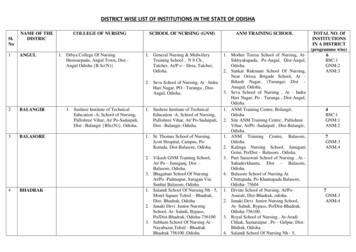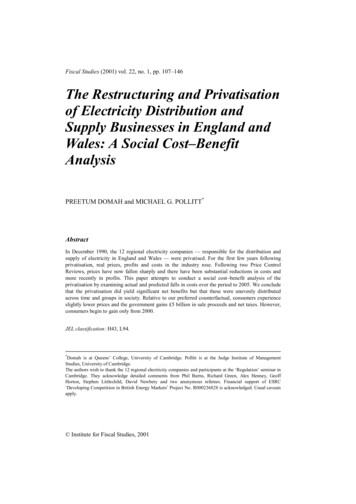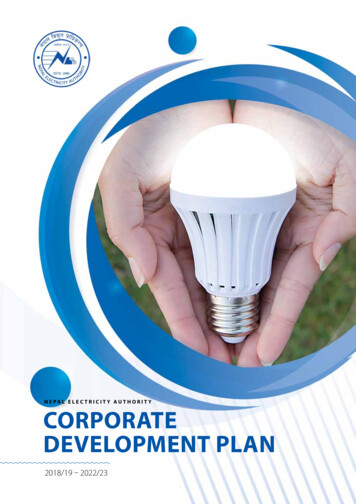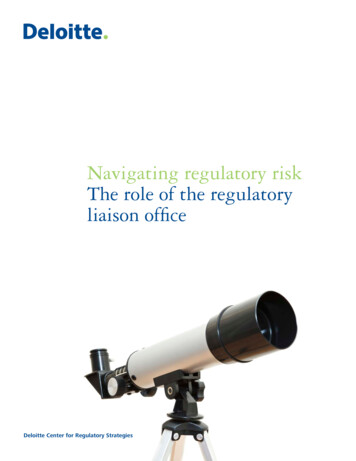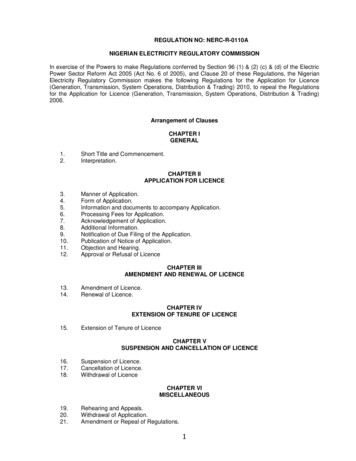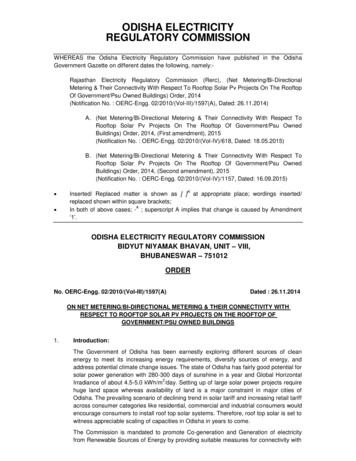
Transcription
ODISHA ELECTRICITYREGULATORY COMMISSIONWHEREAS the Odisha Electricity Regulatory Commission have published in the OdishaGovernment Gazette on different dates the following, namely:Rajasthan Electricity Regulatory Commission (Rerc), (Net Metering/Bi-DirectionalMetering & Their Connectivity With Respect To Rooftop Solar Pv Projects On The RooftopOf Government/Psu Owned Buildings) Order, 2014(Notification No. : OERC-Engg. 02/2010/(Vol-III)/1597(A), Dated: 26.11.2014)A. (Net Metering/Bi-Directional Metering & Their Connectivity With Respect ToRooftop Solar Pv Projects On The Rooftop Of Government/Psu OwnedBuildings) Order, 2014, (First amendment), 2015(Notification No. : OERC-Engg. 02/2010/(Vol-IV)/618, Dated: 18.05.2015)B. (Net Metering/Bi-Directional Metering & Their Connectivity With Respect ToRooftop Solar Pv Projects On The Rooftop Of Government/Psu OwnedBuildings) Order, 2014, (Second amendment), 2015(Notification No. : OERC-Engg. 02/2010/(Vol-IV)/1157, Dated: 16.09.2015) AInserted/ Replaced matter is shown as [ ] at appropriate place; wordings inserted/replaced shown within square brackets;AIn both of above cases; - ; superscript A implies that change is caused by Amendment„1‟.ODISHA ELECTRICITY REGULATORY COMMISSIONBIDYUT NIYAMAK BHAVAN, UNIT – VIII,BHUBANESWAR – 751012ORDERNo. OERC-Engg. 02/2010/(Vol-III)/1597(A)Dated : 26.11.2014ON NET METERING/BI-DIRECTIONAL METERING & THEIR CONNECTIVITY WITHRESPECT TO ROOFTOP SOLAR PV PROJECTS ON THE ROOFTOP OFGOVERNMENT/PSU OWNED BUILDINGS1.Introduction:The Government of Odisha has been earnestly exploring different sources of cleanenergy to meet its increasing energy requirements, diversify sources of energy, andaddress potential climate change issues. The state of Odisha has fairly good potential forsolar power generation with 280-300 days of sunshine in a year and Global Horizontal2Irradiance of about 4.5-5.0 kWh/m /day. Setting up of large solar power projects requirehuge land space whereas availability of land is a major constraint in major cities ofOdisha. The prevailing scenario of declining trend in solar tariff and increasing retail tariffacross consumer categories like residential, commercial and industrial consumers wouldencourage consumers to install roof top solar systems. Therefore, roof top solar is set towitness appreciable scaling of capacities in Odisha in years to come.The Commission is mandated to promote Co-generation and Generation of electricityfrom Renewable Sources of Energy by providing suitable measures for connectivity with
the Grid and sale of electricity to any person under Section 86 (e) of the Electricity Act,2003. Keeping this in view, the Commission have decided to issue this order onNet-metering/ Bi-directional metering for roof top solar generation project including its LTconnectivity for Government/ PSU owned buildings only.A 1[ The order dated 26.11.2014 on Net Metering / Bi-directional Metering and theirconnectivity with respect to Rooftop Solar PV Projects on the rooftop of Government/APSU owned buildings shall now be extended to rooftop of all other buildings also.]2.3.Definitions:(a)“Net-Meter” means a consumer meter which is a bi-directional energy meterfor measuring the quanta of electricity flowing in opposite directions and the netquantum of electricity either consumed by the consumer or injected into thedistribution system of the licensee in kWh; which shall be an integral part of thenet metering system.(b)“Bi-directional Meter” means a consumer meter for measuring, indicating andrecording quanta of electricity flowing in opposite directions (export to thelicensee‟s distribution system and import by the consumer from distributionsystem) in Kwh including any other quantity as per the requirement. The netquantum of electricity either injected to the distribution system or imported bythe consumer in Kwh is derived by arithmetical means. In case the meter isfixed with HT consumers the power factor will be based on the import of energyonly.(c)Eligible consumers for Net-metering/ Bi-directional Metering: “EligibleConsumer” means a consumer of electricity in the area of supply of thedistribution licensee, who uses a rooftop solar system installed in the consumerpremises, to offset part or all of the consumer's own electrical energyrequirements, given that such systems can be self-owned or third party owned.Both the existing and new Solar rooftop/Solar systems which comply with thisorder are eligible for Net-metering/ bi-directional metering.(d)“Settlement period for energy accounting” means the period ending 31March of the relevant financial year.stNet-metering/ Bi-directional Metering based rooftop Solar PV Project:The net metering/bi-directional metering based rooftop solar projects facilitatesself-consumption of electricity generated by the rooftop project and allows for feedingthe surplus energy into the network of the distribution licensee. In the context of thestate of Odisha the following may be the ownership arrangements for installation of suchnet metering based rooftop solar systems:-Self-owned arrangement wherein rooftop owner also owns the PV system.-Third party ownership in which a developer owns the PV system and alsoenters into a lease/commercial arrangement with the rooftop owner.A 2[ In case of defective net metering/ bi-directional metering, the followings shall apply:(a)If the solar net-metering facility has been in service for more than 12 months:The active energy import, active energy export and active energy net importreadings of the corresponding period of the previous year will be taken for billingpurpose by the DISCOMs.(b)12If the solar net-metering facility has been in service for less than 12 months:Inserted text at the end of the clause 1, vide First amendment (A), 2015.Inserted text at the end of the clause 3, vide First amendment (A), 2015.
The net active energy to be billed by DISCSOM per month (Average energyconsumption (imported active energy) during the last three billing cycles prior tothe installation of the bi-directional/ net meter) - KWP of Solar PV generator xA124.]4.Self-owned, net metering/ bi-directional based rooftop Solar PV Project:In a self owned, net metering/ bi-directional metering based rooftop PV model, therooftop owner, who is also the electricity consumer for the utility installs the rooftop solarsystem at his own cost. The electricity generated by the system is first used to serviceconsumer‟s captive load within the rooftop owner‟s premises. The solar powergenerated in excess of the owner‟s electricity consumption is fed into the grid through anet-meter/ bi-directional meter. This net-generation is then credited to the owner‟saccount and adjusted subsequently against imports from the grid in the mannerspecified in this order.5.Third party owned Rooftop PV net metering/ Bi-directional metering:In the third party owned rooftop PV net metering/ bi-directional metering model, thedevelopers or intermediaries lease out solar PV systems to interested rooftop owners. Inthis arrangement, the turnkey installers lease rooftop systems to individual owners ofthe building. Alternatively, the installers can also offer an integrated service of leasing,commissioning and maintaining the systems to owners and guaranteeing standards ofperformance. The electricity generated from such a system is used to meet the rooftopowner‟s internal electricity needs while the excess generation is fed into the grid on netmetering/bi-directional metering basis.A 3[ Third party sale of the power generated from the Rooftop Solar PV is not permitted.The power generated shall be utilized for self consumption of the consumer and surplusApower shall be injected into the Grid. The banking of electricity is also not allowed.]6.Capacity Limits:The capacity of an individual rooftop PV system would be the available capacity of theservice line connection, i.e. the sanctioned load of the consumer. The installation of netmetered bi-directional metered rooftop solar systems on consumer premises will utilizethe same service line and installation which is currently being used by the consumer fordrawal of power from utility network for injection of excess power into the Grid. Anoverview of basic grid interactive photovoltaic system is placed at Annexure-I.A 4[ The cumulative Grid injection is capped at 30% of the distribution transformerAcapacity.]7.Interconnection arrangements:Net-metering/bi-directional metering facility shall be extended to the solar power systeminstalled in consumer premises. These consumers are the “eligible consumers” for thepurpose of net-metering/ bi-directional metering. Interconnection framework fornet-metering shall address parameters including connecting voltage level, minimumtechnical standards for interconnection as would be indicated by the Commission fromtime to time under relevant regulations and orders including Orissa ElectricityRegulatory Commission Distribution (Conditions of Supply) Code, 2004 andamendments thereto and as per technical standards for Connectivity of DistributedGeneration resources Regulations 2013 and amendments thereto notified by CentralElectricity Authority.34Inserted text at the end of the clause 5, vide First amendment (A), 2015.Inserted text at the end of the clause 6, vide First amendment (A), 2015.
8.Application:The consumer shall make an application in the prescribed format (Annexure – II) to thedistribution utility along with a fee of INR 500/- (Indian Rupees Five hundred Only). Theconsumer can download the solar net-metering / bi-directional metering rooftopapplication form from the website of the distribution utility. It can also be obtained fromconcerned sub-division office. Before availing the permission for solar net metering /bi-direction metering of rooftop solar PV project the consumer is to enter into anagreement with the distribution licensee in the Standard Agreement Form. Permissionwill be normally issued within 15 days from the date of submission of the application tothe distribution utility in their Division offices provided there is feasibility for connectivityand fulfilment of other documentary requirements as per Regulations in force.9.Restrictions on level of overall or local grid penetration:To address technical, safety and grid security issues arising out of possible reverse flowof electricity in the local grids, the distribution licensee shall provide net metering/bi-directional metering arrangement to all eligible consumers as long as the cumulativecapacity to be allowed for a particular distribution transformer shall not exceed 30% ofthe capacity of the distribution transformer.The quantum of electricity consumed by an eligible consumer, who is not defined as anobligated entity from the rooftop solar system under net-metering / bi-directionalmetering arrangement shall qualify as deemed Renewable Purchase Obligation (RPO)for the distribution licensee/bulk supplier.10.Metering Arrangement:Two meters would have to be installed by the solar power generator. One is formeasuring solar generation and the other one is for Import/Export measurement. Thefirst meter, the solar generation meter, has to be installed at the generator end after theinverter at the ground floor of the premises to facilitate easy access for meter reading.The second meter is a net meter / bi-directional meters (single phase or three phase asper requirement) capable of recording import and export of power in kWh and shall beaccepted for commercial settlements. These meters should be MRI and AMR compliant.If the consumer wishes to have a record of the reading taken, he shall be allowed to doso by the licensee. The second meter have to be installed at the same location wherethe present meter for consumption is installed and the present meter for drawal of powerfrom distribution utility shall be removed. The meter rent remaining unpaid at the time ofinstallation of new meters if any shall be waived by the distribution utility.Provided that till the BIS and CEA standards are available the followingstandards shall be followed. Once the standards are available, all the net meter /bi-directional meter to be installed shall follow the relevant guideline. The existing netmeter / bi-directional meter already installed before the publication of standards shall beallowed to continue.Provided that for HT connections (11kV and above), the applicablemeter can be a bidirectional meter (Category-B) and complying with the existingIS-14697 and IS 15959 standards.A 5[ Provided that for LT connections (below 11kV), the applicable metershall comply with the existing meter standards IS-13779 with additional requirement of5rdOmitted and inserted 3 proviso of para 10 “Metering Arrangements”, vide Second amendment (B),2015.
two registers, as Import and Export register, to record the import and export ofelectricity.Provided that for LT connections (below 11kV), the applicable meter shallcomply with the existing meter standards IS 14697 for CT operated static watt-hour metersand IS-13779 for ac static watt hour meters with additional requirement of two registers, asImport and Export register, to record the import and export of electricity.]AProvided further that all the meters should also comply with IS-15959(Indian Standards for Data Exchange for electricity meters). There shall be a separateSolar Generation Meter to record the total solar generation in the consumer premisesafter the power conditioning unit.11.(a)The meters shall adhere to the standards for consumers specified by theCentral Electricity Authority (Installation and Operation of Meters) Regulations,2006 and Central Electricity Authority (Installation and Operation of meters)Amendment Regulations, 2010 as amended from time to time.(b)The Distribution Licensee shall host the list of approved manufacturers of suchmeters in their website.(c)Check meter shall be installed for the solar energy system having capacity morethan 20kW and for the solar energy system of capacity less than or equal to 20kW, the check meter would be optional.(d)The cost of meters, cost of connectivity and all other related cost for setting upthe meters etc. have to be borne by the eligible consumers under guidance ofthe concerned distribution licensee. Either consumer or distribution licenseeshall procure the meter. The distribution licensee shall test and install the same.(e)The meters installed shall be jointly inspected and sealed by the Licensee onbehalf of both the parties. It shall be tested by the licensee and installed in thepresence of the representatives of the consumer or himself and the distributionlicensee with due acknowledgement. In case desired by the consumer thelicensee shall allow the presence of the same during testing by intimating testdate and time in advance. Position & sealing of meters will be guided by thesame provisions as applicable to consumer meters in the Central electricityAuthority‟s Metering Regulations/Supply Code.(f)The meter reading, both net meter and solar generation meter shall be taken bythe distribution licensee and shall form the basis for commercial settlement. Thecopy of the meter reading statement shall be handed over to the consumer assoon as meter reading is taken.Energy Accounting:(a)Electricity generated from a Solar rooftop PV project shall be cappedcumulatively at 90% of the electricity consumption by the eligible consumer atthe end of a settlement period which ends with the financial year to allow forseasonality in generation. In case of the financial year where CommercialOperation Date (COD) occurs, the 90% capping shall be on the energyconsumed by the consumer from the date of COD to the end of the financialyear.(b)The carry forward of excess energy generation will be allowed from one billingcycle to the next billing cycle till the end of the same financial year. Any excessgeneration (above 90 per cent) at the end of the financial year would beconsidered as free energy and shall not be offset against the consumer‟sconsumption. There shall not be any carry forward of energy to the nextfinancial year.
(c)12.The imported energy shall be eligible for normal ToD benefit as per the order ofthe Commission prevailing at that time.Billing and Payment:13.(a)The consumer shall receive a monthly net import/export bill indicating either netexport to the Grid or net import from the Grid.(b)In case of net import bill, i.e. if any electricity is supplied by the distributionlicensee to the consumer, the distribution licensee shall raise invoice for the netelectricity imported after taking into account any carry forward of energy fromprevious billing periods in the same financial year. The net energy imported hasto be billed by the Distribution Licensee as per the tariff in force applicable tothat category of consumers.(c)In case of export of energy in excess of the consumption of the consumer in abilling cycle shall be carried forward to the next billing cycle for adjustmentagainst next month‟s import bill if any. No interest will be payable on this carryforward energy amount.LT Connectivity:(a)The Technical Standards for connectivity shall be as specified in the CEA‟s(Technical Standards for connectivity of the Distributed Generating Resources)Regulations, 2013 and as amended from time to time.(b)The maximum capacity for interconnection with the distribution licensee‟ssystem at a specific voltage level shall be limited to the contract demand of theconsumer as per his agreement with the distribution licensee subject tomaximum 1 MW for a single net / bi-directional metering point.(c)The important clauses related to the technical and interconnection requirementsare provided below:ParameterReferenceRequirementOverall conditions ofserviceOERC Distribution (Conditionsof Supply) Code, 2004 andamendments theretoReference to regulationsOverall Grid StandardsCEA (Grid Standard)Regulations, 2010Reference to regulationsEquipmentBIS / IEC / IEEEReference to regulationsMetersCEA (Installation & operationof meters) Regulation 2006and amendment theretoReference to regulations andadditional conditions issued byOERCSafety and supplyCEA ( Measures relating toSafety and Electricity Supply)Regulations, 2010Reference to regulationsHarmonic CurrentIEEE 519Harmonic current injections from agenerating station shall not exceedthe limits specified in IEEE 519CEA (Technical Standards forConnectivity of the DistributedGeneration Resources)Regulations, 2013
SynchronizationIEEE 519CEA (Technical Standards forConnectivity of the DistributedGeneration Resources)Regulations, 2013VoltageIEEE 519CEA (Technical Standards forConnectivity of the DistributedGeneration Resources)Regulations, 2013FlickerIEEE 519CEA (Technical Standards forConnectivity of the DistributedGeneration Resources)Regulations, 2013FrequencyIEEE 519CEA (Technical Standards forConnectivity of the DistributedGeneration Resources)Regulations, 2013DC injectionIEEE 519CEA (Technical Standards forConnectivity of the DistributedGeneration Resources)Regulations, 2013Power FactorIEEE 519CEA (Technical Standards forConnectivity of the DistributedGeneration Resources)Regulations, 2013Islanding andDisconnectionIEEE 519Overload and OverheatIEEE 519CEA (Technical Standards forConnectivity of the DistributedGeneration Resources)Regulations, 2013CEA (Technical Standards forConnectivity of the DistributedPhotovoltaic system must beequipped with a grid frequencysynchronization device. Every timethegeneratingstationissynchronized to the electricitysystem it shall not cause voltagefluctuation greater than /- 5% atpoint of connection.Thevoltage-operatingwindowshould minimize nuisance trippingand should be under operatingrange of 80% to 110% of thenominalconnectedvoltage.Beyond a clearing time of 2second, the photovoltaic systemmust isolate itself from the grid.Operation of Photovoltaic systemshould not cause voltage flicker inexcess of the limits stated in IEC61000standardsorotherequivalent Indian standards, if anyWhen the Distribution systemfrequency deviates outside thespecified conditions (50.5 Hz onupper side and 47.5 Hz on lowerside), There should be over andunder frequency trip functions witha clearing time of 0.2 seconds.Photovoltaic system should notinject DC power more than 0.5% offullratedoutputattheinterconnection point or 1% of ratedinverteroutputcurrentintodistribution system under anyoperating conditions.While the output of the inverter isgreater than 50%, a lagging powerfactor of greater than 0.9 shouldoperate.The photovoltaic system in theevent of fault, voltage or frequencyvariations must island/disconnectitself within IEC standard onstipulated period.The inverter should have the facilityto automatically switch off in caseof overload or overheating andshouldrestartwhennormal
Paralleling DeviceGeneration Resources)Regulations, 2013conditions are restored.IEEE 519Paralleling device of photovoltaicsystem shall be capable ofwithstanding 220% of the normalvoltage at the interconnection point.CEA (Technical Standards forConnectivity of the DistributedGeneration Resources)Regulations, 201314.Operation and Maintenance(a)The solar rooftop PV projects shall comply with the relevant standards andguidelines specified by the MNRE / BIS and CEA. The responsibility ofoperation and maintenance of the solar rooftop PV projects including all itsaccessories and apparatuses lies with the consumer. The design andinstallation of the solar rooftop PV project should be equipped with appropriatelyrated protective devices to sense any abnormality in the system and carry outautomatic isolation of the solar rooftop PV project from the network of theDistribution Licensee. The inverters used should meet the necessary qualityrequirements as specified and checked by the Supply Engineer before puttinginto service. The protection logics should be tested before commissioning of theplant. The installation shall meet all safety standards and safety certificates forthe installations should be obtained from the appropriate authorities.(b)The automatic isolation or islanding protection of solar rooftop PV projectsshould be ensured for, no grid supply, low or over voltage conditions and withinthe required response time. Fuses and fast acting circuit breakers of adequaterating on input and output side of the inverters and disconnect / isolatingswitches to isolate DC and AC system for maintenance shall be provided. Theconsumer should provide for all internal safety and protective mechanism forearthing, surge, DC ground fault, transients etc. as per the CEAregulation/standards.(c)To prevent back feeding and possible accidents when there is no supply fromdistribution licensee‟s side, Double pole /Triple pole isolating disconnectswitches which can be locked by distribution licensee personnel should beprovided by the consumer. This is in addition to automatic sensing and isolatingon grid supply failure etc and also in addition to internal disconnect switches. Inthe event of distribution licensee‟s supply failure, the consumer has to ensurethat there will not be any solar power being fed to the system of distributionlicensee. The consumer is solely responsible for any accident to human beings/animals whatsoever (fatal /non-fatal / departmental /non-departmental) thatmay occur due to back feeding from the solar rooftop PV projects when there issupply failure from distribution licensee‟s side. Distribution licensee reserves theright to disconnect the installation at any time in the event of damage to its grid,meter, etc. or to prevent further accident or damage.(d)The consumer shall abide by all the codes and regulations issued by theCEA/OERC to the extent applicable and in force from time to time. Theconsumer shall comply with CEA/IEGC/OGC/OERC/distribution licensee‟srequirements with respect to safe, secure and reliable function of the Solarrooftop PV projects. The power injected into the distribution licensee‟s systemshall be of the required quality in respect of wave shape, frequency, harmonicstandard and absence of DC components etc.
(e)The Solar rooftop PV projects shall restrict the harmonic generation within thelimit specified in the agreement or specified by the Central Electricity Authorityby regulation.(f)The Solar rooftop PV projects established under net metering/ bi-directionalmetering procedure may have also battery backup.When the consumer prefers LT connectivity with battery backup (full loadbackup/partial load backup), the inverter shall have separate backup wiring toprevent the battery/DG power from flowing into the grid in the absence of gridsupply and manual isolation switch shall also be provided. The manual isolationswitch shall have locking facilities to enable distribution licensee personnel tokeep it switched off and locked during maintenance works.15.(g)The inverter standard shall be such that it should not allow solar power/batterypower/DG power to extend to distribution licensee‟s supply system on failure ofdistribution licensee‟s grid supply, irrespective of the LT connectivity options.(h)The inverter should be a sine wave inverter. Harmonic standards shall be as perIEEE 519. To avoid DC injection into the grid and to ensure other power qualityparameters, the AC output of the inverter shall be connected through anIsolation Transformer to the distribution licensee‟s system.(i)Application for rooftop Solar PV Project connectivity shall be submitted to theconcerned section officer along with application fee specified in this order.(j)The net-metering / bi-directional metering connection agreement is furnished inAnnexure-IIIApplicability of Renewable Energy Certificates and RPOSolar Energy generated by Net-metering/ bi-directional metering project is not eligiblefor Renewable Energy Certificate (REC). The energy generated by an eligibleconsumer, who is not defined as an obligated entity from the rooftop solar PV projectsunder net-metering arrangement shall qualify as deemed Renewable PurchaseObligation (RPO) for the distribution licensee/ bulk supply licensee. The DistributionLicensee shall furnish a copy of solar energy generated by the eligible consumer toGRIDCO.By Order of the CommissionSd/SECRETARY
Rajasthan Electricity Regulatory Commission (Rerc), (Net Metering/Bi-Directional Metering & Their Connectivity With Respect To Rooftop Solar Pv Projects On The Rooftop Of Government/Psu Owned Buildings) Order, 2014 (Notification No. : OERC-Engg. 02/2010/(Vol-III)/1597(A), Dated: 26.11.2014) A. (Net Metering/Bi-Directional Metering & Their .




